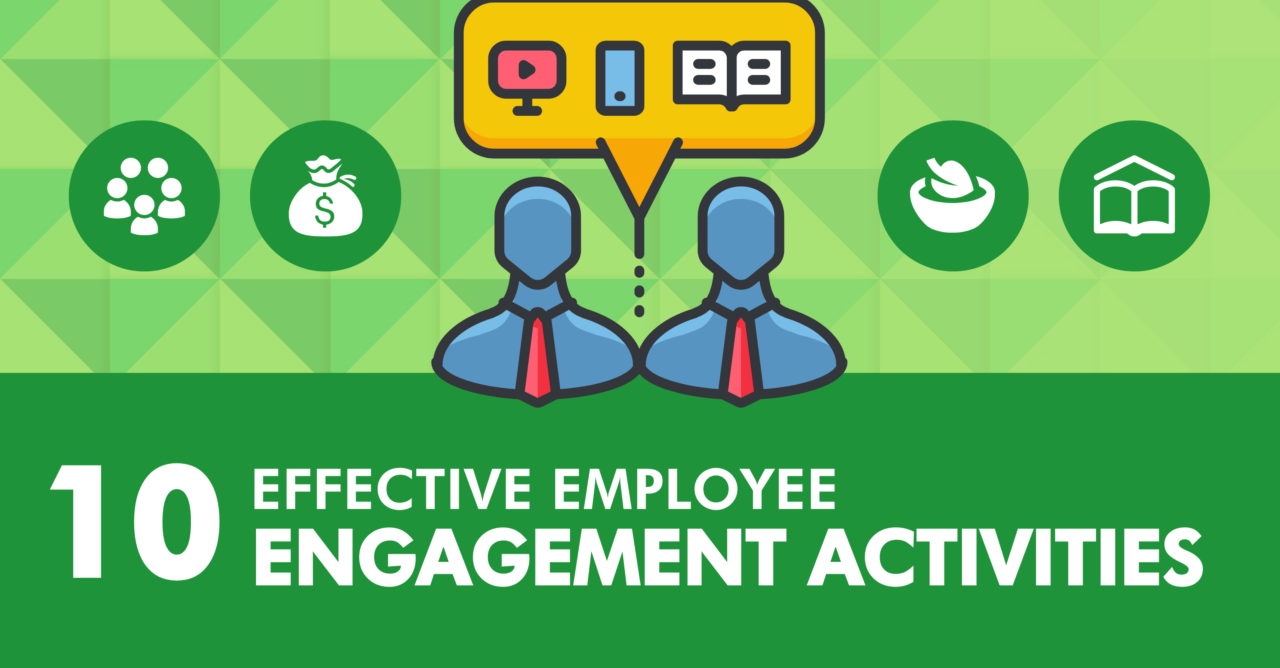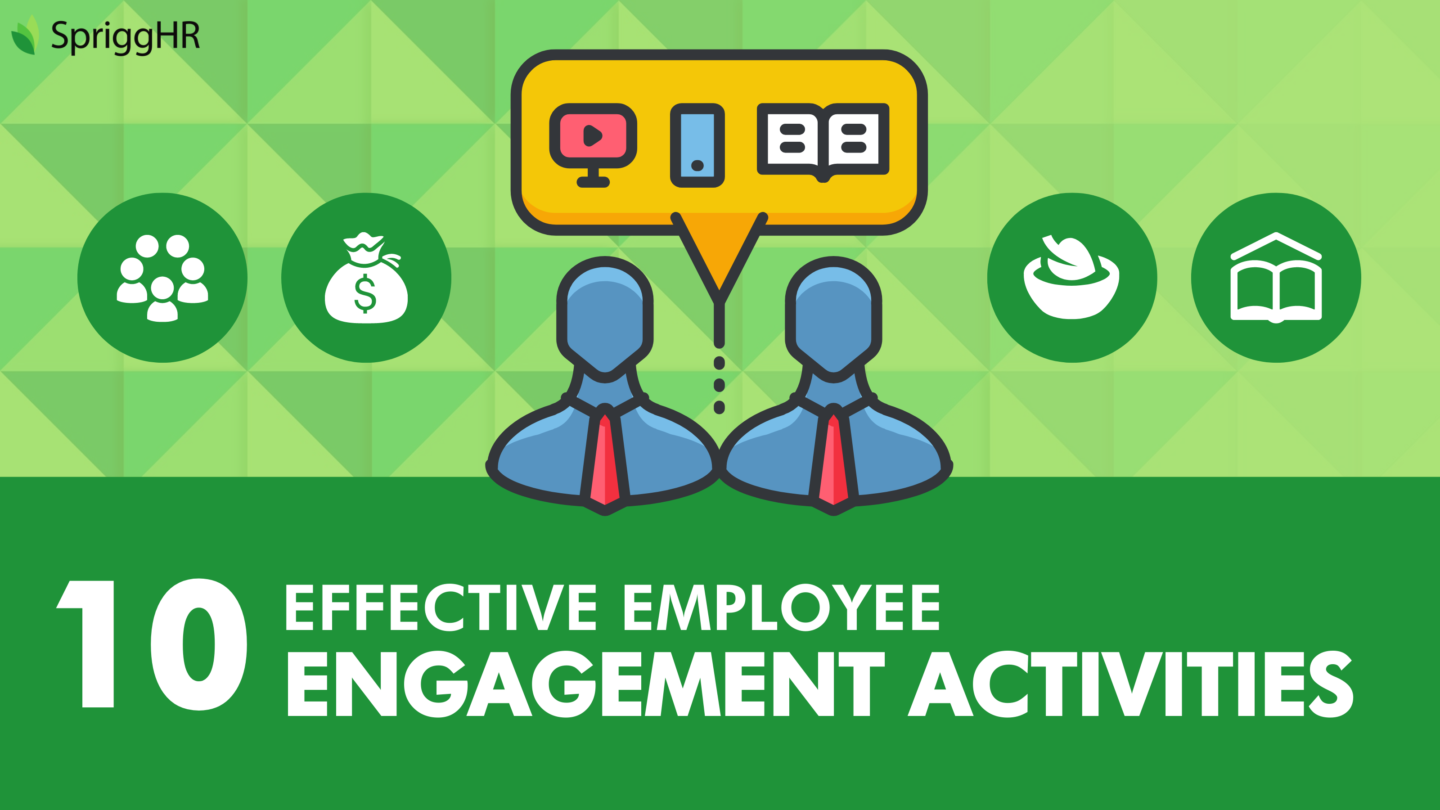
10 Effective Employee Engagement Activities
What is Employee Engagement?
Employee engagement, in general, refers to the emotional commitment an employee has to the organization and its goals. Engaged employees are those who truly care about the work and the company, those who work on behalf of the goals of the organization as well as their own personal success. When a workforce has a high employee engagement rate, their employees use discretionary effort, a motivated effort in job performance that leads to higher sales and fewer mistakes.
Organizations that value employee engagement see much greater benefits than those who choose not to implement the essential programs that drive increased performance levels. When a company puts consistent efforts into formulating employee engagement activities, they can reap the following:
- A reduction in staff turnover (improved retention / lower churn)
- An improvement in productivity and efficiency
- Retention of customers at a higher rate
- An increase in overall profits for the organization
Engaged employees are happier both at work and in their lives. Effective employee engagement infuses their work experience with purpose, energy, and enthusiasm. Instilling a strong curriculum of employee engagement activities may be challenging for employers, but it allows for a great opportunity to gain long-term commitment and discretionary efforts from the team.
Benefits of Effective Employee Engagement
Improving employee engagement can boost an organization’s performance in several different ways. Companies that seek to enrich the quality of employee engagement activities offered in the workplace typically see the largest improvements in the following areas:
Profitability & Attrition
Engaged employees are more present and productive, more attuned to the needs of the customers, and are more observant of processes, standards, and systems. As a result, the potential for an increase in profits is much more obtainable when every member of a team is highly engaged. In fact, a study conducted by Gallup found that behaviors of highly engaged business units result in 21% greater profitability.
Operating Income
In a research case conducted by David MacLeod and Nita Clarke for the UK government, their findings concluded that companies with high levels of employee engagement improved their operating income by 19%, while companies with low levels of employee engagement had an operating income that declined by 33%.
Customer Loyalty, Productivity, and Employee Turnover
Optimizing productivity levels is one of any organization’s greatest challenges, and customer loyalty is what companies depend on to sustain existence and growth. In the same study conducted by Gallup, the influence that effective employee engagement activities had on these elements of an organization’s success was exhibited in the following findings:
Highly engaged business units achieve a;
- 10% increase in customer ratings
- 20% increase in sales
- 41% reduction in absenteeism
- 17% increase in productivity
In high turnover organizations (> 40% annualized turnover):
- Highly engaged business units achieve 24% less turnover
In low turnover organizations (≤ 40% annualized turnover):
- Highly engaged business units achieve 59% less turnover
Cost of Disengagement
While many statistics point to the benefits of effective employee engagement, it can also be useful to consider the detriments that poor employee engagement can have on an organization, particularly financially. The Engagement Institute is a joint group comprised of The Conference Board, Sirota-Mercer, Deloitte, ROI, The Culture Works, and Consulting LLP. They conducted a study of over 1,500 respondents, in which they found that:
Disengaged employees can cost companies between $450 and $550 billion a year.

Effective Employee Engagement Activities
For an organization to realize its goals of increasing employee engagement, they must commit to acting. Unfortunately, the shift from theory to practice can be challenging for many employers. Too often do companies measure engagement, then do little to act on improving it. Below are some examples of employee engagement activities that will help employees understand the company vision, its strategic direction, and their individual role and importance in the efforts of achieving it.
1. Involve Employees in the Planning Process
Every 6 months, or even quarterly, aim to present the important issues the company is encountering, and the actions that were or will be made to address those issues. This works to consistently involve the entire team in planning ahead, assessing the opportunities for success, and generating ideas that will improve the overall business strategy being employed.
By including employees in the planning process, it promotes transparency within the workplace, and offers strategic insight into how the company is managed. Resulting in, strengthened loyalty of employees while building an inclusive and participative company work culture that clearly values its employees perspectives.
2. Set Up a Knowledge Sharing System
We know that ineffective employee engagement strategies lead to a higher turnover rate. With that, there comes a detrimental cost to the company in terms of a regular loss of essential information. A knowledge sharing system helps to avoid that cost and can also act as an engagement driver for newcomers to the workforce. Some examples of knowledge sharing systems you could introduce in your organization include:
- A mentorship program, in which you pair an experienced employee with a newly hired employee for the dissemination of essential information.
- The use of communication software in a way that encourages consistent open dialogue amongst employees (and that summarizes discussion points surrounding a project).
- Creating a series of monthly focus groups represented by a cross-section of employees who share their direct experiences and insights
3. Creative Knowledge Sharing
Too often in companies are teams isolated within their own workspace and the details of their own projects. To deter from this, aim to introduce an open sharing space once every 2 months or so, in which all the teams present updates on their active goals and projects while highlighting the key learning points they’ve encountered since the last check-in. By promoting consistent communication of each team’s progress, they will evolve much more rapidly because they will have the ability to draw on shared knowledge and the different experiences of every project.
Introduce unique and creative approaches to these meetings. For example, set a theme for each meeting, in which the teams will then need to adapt their presentation style(s) to fit the theme. Remember, creativity is a key driver in employee satisfaction and engagement.
4. Be Transparent with Finances
There is little that builds trust within a company more than being completely transparent with financial statements. An effective employee engagement activity would be to have quick presentations on the financial state of the company every quarter or end-year. In these meetings, aim to show how every effort within the company is linked, set bold financial objectives for the next months, and get every individual involved in meeting those objectives.
If you want employees to put in discretionary effort on a regular basis, encourage them to take responsibility for the overall financial success of the company.
5. Encourage and Provide Learning Opportunities
Turn learning opportunities into something fun and creative to keep employees interested. Develop your own Academy of sorts, where employees have regular access to the knowledge and development opportunities they need to succeed in their roles.
Make efforts to access your employees’ needs and preferences, then work to create a curriculum that addresses those needs, setting up one or two classes per week. Involve them in the planning process of when to schedule these learning initiatives to ensure maximum engagement is achieved.

6. Consistently Promote Employee Wellbeing
Disengaged employees are often at the risk of feeling unsupported by their organization in terms of balancing their personal lives with their work lives. A recent Glassdoor survey found that up to 87% of employees expect their employer to support them in balancing work and personal commitments. Even more convincing is the American Psychological Association’s finding that 89% of workers at companies that support well-being initiatives are more likely to recommend their company as a good place to work.
Aim to get creative in involving employees on a personal level, offering engagement activities that promote employee well-being in a fun and effective way. For example, holding an Office Olympics that promotes the benefits of a healthy lifestyle would be an effective way to address the personal concerns of some of your employees, without the pressure of formal one-on-one meetings.
7. Set Up an Ambitious Hack Night
Establish a clear objective, create a specific set of rules to follow including parameters on breaks, music, snacks, etc., and aim to be as productive as possible in just one night. Not only does it provide your organization with a bout of incredible work output, it also turns the aim towards productivity into something fun and engaging for your employees. Getting everyone together to test creative and operational limits introduces a healthy competitive element in the workplace, transforming team efforts from a typical workday to an opportunity of creativity and camaraderie building.
8. Generate Excitement About Upcoming Opportunities
One of the top reasons that employees choose to leave a company is the lack of learning prospects. By aiming to communicate upcoming learning opportunities on a regular basis, you effectively get employees excited and striving for what’s next in their own professional future. Some ways to regularly communicate these opportunities would be through the internal newsletter, face-to-face in the workplace, or including it as a segment of general update meetings.
9. Create a Self-Paced Onboarding Experience
New employees are much more likely to recall and assimilate information that they’ve obtained from their own efforts. During the onboarding experience, set the grounds rules, provide basic instructions, a list of objectives, and a timeframe, then step back and allow the newly hired employees to take the lead in training themselves. For example, a 90-day plan with basic information and milestones placed throughout.
Too often do onboarding processes fail to provide actual value to the employee’s initial experience of a company, and many also fail to initiate any sort of productive dialogue within the organization. By allowing employees to in part, craft their own onboarding experience and figure out their work preferences, you are much more likely to keep them engaged in the future as they will have adapted to the demands of the job in the way that best suits their working style.
10. Give Back
Get the company involved in social and charity initiatives. Regularly get the team together and have everyone pitch a cause they deem worthy, voting on one to support for a given amount of time, choosing to donate time and involvement or money, or both. This fosters a positive mentality within the workforce, giving the employees an opportunity to feel proud and loyal to be working for the organization.
Final Thoughts
Employee engagement is an organizational effort that requires a long-term vision in business strategy. When devising a plan for organizing effective employee engagement activities, you must be able to identify the specific needs of your company and develop your strategy around those. Only then can you measure engagement and adapt your strategies to lean towards an increase in those rates.
Engaged employees are an incredibly valuable human resource. They are passionate about the work they do, deliver true customer service value, and achieve organizational objectives. Employee engagement has a profound effect on an organization’s revenue, profitability, and overall longevity.




